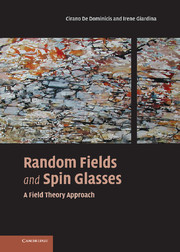Book contents
- Frontmatter
- Contents
- Preface
- List of abbreviations
- 1 A brief introduction
- 2 The Random Field Ising Model
- 3 The dynamical approach
- 4 The p = 2 spherical model
- 5 Mean field spin glasses: one-step RSB
- 6 The Sherrington–Kirkpatrick Model
- 7 Mean field via TAP equations
- 8 Spin glass above D = 6
- 9 Propagators, mostly replicon
- 10 Ward–Takahashi Identities and Goldstone modes
- 11 Alternative approaches and conclusions
- Appendix A Renormalization at one loop: ϕ4 theory (pure Ising)
- Appendix B Renormalization at one loop: tr ϕ3 theory (spin glass)
- Index
5 - Mean field spin glasses: one-step RSB
Published online by Cambridge University Press: 21 October 2009
- Frontmatter
- Contents
- Preface
- List of abbreviations
- 1 A brief introduction
- 2 The Random Field Ising Model
- 3 The dynamical approach
- 4 The p = 2 spherical model
- 5 Mean field spin glasses: one-step RSB
- 6 The Sherrington–Kirkpatrick Model
- 7 Mean field via TAP equations
- 8 Spin glass above D = 6
- 9 Propagators, mostly replicon
- 10 Ward–Takahashi Identities and Goldstone modes
- 11 Alternative approaches and conclusions
- Appendix A Renormalization at one loop: ϕ4 theory (pure Ising)
- Appendix B Renormalization at one loop: tr ϕ3 theory (spin glass)
- Index
Summary
Let us now consider mean field models of spin glasses where, contrary to the simple case studied in the previous chapter, the quenched disorder dramatically affects the thermodynamics. For these models, as we shall see, the replica method not only represents a necessary mathematical tool to perform the computations, but also offers an appropriate description of the nontrivial low temperature physics.
When looking at the thermodynamics of the p = 2 spin model using replicas we ended up with a Lagrangian (Eq. (4.83)) expressed in terms of an overlap matrix Qab. To perform the calculation we had to make an ansatz on the structure of this replica matrix, and we chose the simplest possible one, the Replica Symmetric (RS) ansatz. In that case, this ansatz proved to be appropriate, however, this is in general not true: whenever real spin glass behaviour is encountered the RS solution is not the appropriate one, being unstable and leading to unphysical predictions (such as, for example, negative entropy). Alternative ansatzes for the Qab matrix necessarily involve a breaking of the replica symmetry, and are usually referred to as Replica Symmetry Broken (RSB) solutions.
The correct way to break the symmetry was the main focus of most theoretical research on spin glasses in the late seventies. As it turned out later on, the degree of symmetry breaking necessary to find a stable solution actually depends on the model considered.
- Type
- Chapter
- Information
- Random Fields and Spin GlassesA Field Theory Approach, pp. 79 - 100Publisher: Cambridge University PressPrint publication year: 2006



